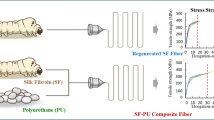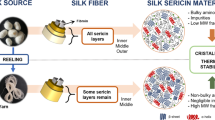Abstract
NATURAL silk is readily soluble in several solvents, such as cupriethylenediamine, lithium bromide and lithium rhodanide, phosphoric acid, etc. Generally, it is assumed that the dissolution is brought about in such a way that the solvent splits the hydrogen-bonds which intermolecularly connect adjacent fibroin chains, attaches itself to the positions now made available and thus transforms the fibroin into a hydrophilic; water-soluble modification. Schauenstein1 stated that this procedure could be followed by means of ultra-violet spectroscopy by virtue of the ‘peptenol’ chromophore, the intensity of which should be a measure of the intermolecular hydrogen-bonding, and which shows a distinct and specific absorption in the region of about 250 mµ. In the course of regeneration experiments with phosphoric acid solutions, different silk samples were investigated in a Beckman spectrophotometer, namely, natural silk, silk dissolved in phosphoric acid (diluted with water), the aqueous silk solution obtained by dialysing the phosphoric acid solution and, finally, films prepared by drying the aqueous solution. The absorption curves obtained are shown in Fig. 1. In view of the above considerations, this result would mean that natural silk contains by far the largest amount of intermolecular bonds, whereas the phosphoric acid solution has lost most of them. Yet the aqueous solution shows an increase in the hydrogen-bonding, and still more so does the film, although without reaching the high value of natural silk.
This is a preview of subscription content, access via your institution
Access options
Subscribe to this journal
Receive 51 print issues and online access
$199.00 per year
only $3.90 per issue
Buy this article
- Purchase on Springer Link
- Instant access to full article PDF
Prices may be subject to local taxes which are calculated during checkout
Similar content being viewed by others
References
Kratky, O., and Schauenstein, E., Z. Naturf., 5 b, 281 (1950).
Coleman, D., and Howitt, F. O., Proc. Roy. Soc., A, 190, 145 (1947).
Signer, R., and Glanzmann, R., Makromol. Chem., 5, 257 (1950).
Ambrose, E. J., Nature, 167, 264 (1951).
Howitt, F. O., “A Bibliography on Silk”.
Author information
Authors and Affiliations
Rights and permissions
About this article
Cite this article
SCHURZ, J. Silk–Phosphoric Acid Solutions. Nature 173, 952–953 (1954). https://doi.org/10.1038/173952a0
Issue Date:
DOI: https://doi.org/10.1038/173952a0
This article is cited by
-
A New Solvent for Silk
Nature (1954)
Comments
By submitting a comment you agree to abide by our Terms and Community Guidelines. If you find something abusive or that does not comply with our terms or guidelines please flag it as inappropriate.



